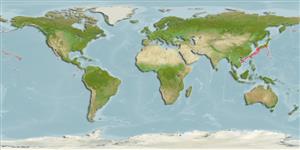Elasmobranquios (tiburones y rayas) (sharks and rays) >
Squaliformes (Sleeper and dogfish sharks) >
Etmopteridae (Lantern sharks)
Etymology: Trigonognathus: Greek, trigono = a triangle + Greek, gnathos = jaw (Ref. 45335). Refers to the triangular shape of the jaws (Ref. 31259); kabeyai: Named after Mr. Hiromichi Kabeya who collected the type specimens (Ref. 31259).
Environment: milieu / climate zone / depth range / distribution range
Ecología
marino batidemersal; rango de profundidad 330 - 360 m (Ref. 31259). Deep-water
Northwest Pacific: Wakayama and Tokushima, Japan (Ref. 31259). Reported from the Hawaiian Islands (Ref. 58302).
Length at first maturity / Tamaño / Peso / Age
Maturity: Lm 52.0 range ? - ? cm
Max length : 47.0 cm TL macho / no sexado; (Ref. 55729); 53.9 cm TL (female); peso máximo publicado: 425.60 g (Ref. 55729); peso máximo publicado: 425.60 g
Specimens collected between 330 and 360 m (Ref. 31259). Ovoviviparous (Ref. 205).
Life cycle and mating behavior
Madurez | Reproducción | Puesta | Huevos | Fecundidad | Larva
Distinct pairing with embrace (Ref. 205).
Mochizuki, K. and F. Ohe, 1990. Trigonognathus kabeyai, a new genus and species of the squalid sharks from Japan. Jap. J. Ichthyol. 36(4):385-390. (Ref. 31259)
IUCN Red List Status (Ref. 130435)
Threat to humans
Harmless
Human uses
Más información
Age/SizeCrecimientoLength-weightLength-lengthLength-frequenciesMorfometríaMorfologíaLarvaDinámica larvariaReclutamientoAbundanciaBRUVS
ReferenciasAcuiculturaPerfil de acuiculturaRazasGenéticaElectrophoresesheritabilidadEnfermedadesProcesamientoNutrientsMass conversion
ColaboradoresImágenesStamps, Coins Misc.SonidosCiguateraVelocidadTipo de nataciónSuperficie branquialOtolitosCerebrosVisión
Herramientas
Special reports
Download XML
Fuentes de Internet
Estimates based on models
Preferred temperature (Ref.
123201): 10.4 - 16.3, mean 11.4 °C (based on 5 cells).
Phylogenetic diversity index (Ref.
82804): PD
50 = 1.0000 [Uniqueness, from 0.5 = low to 2.0 = high].
Bayesian length-weight: a=0.00372 (0.00188 - 0.00734), b=3.10 (2.92 - 3.28), in cm total length, based on LWR estimates for this (Sub)family-body shape (Ref.
93245).
Nivel trófico (Ref.
69278): 4.5 ±0.4 se; based on diet studies.
Resiliencia (Ref.
120179): Bajo, población duplicada en un tiempo mínimo de 4.5-14 años (Fec assumed to be <100).
Fishing Vulnerability (Ref.
59153): Moderate vulnerability (42 of 100).
